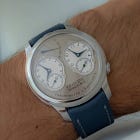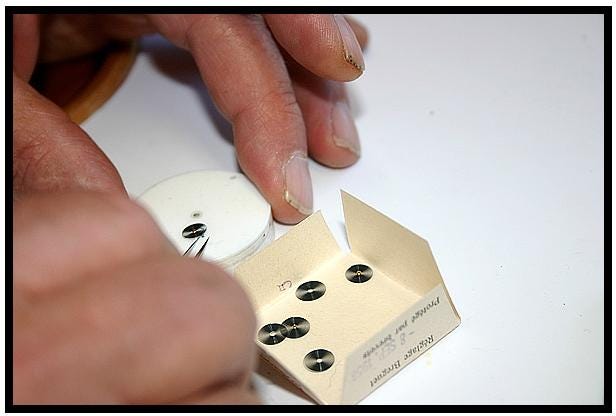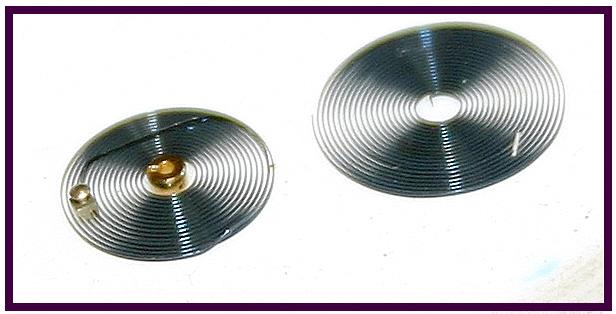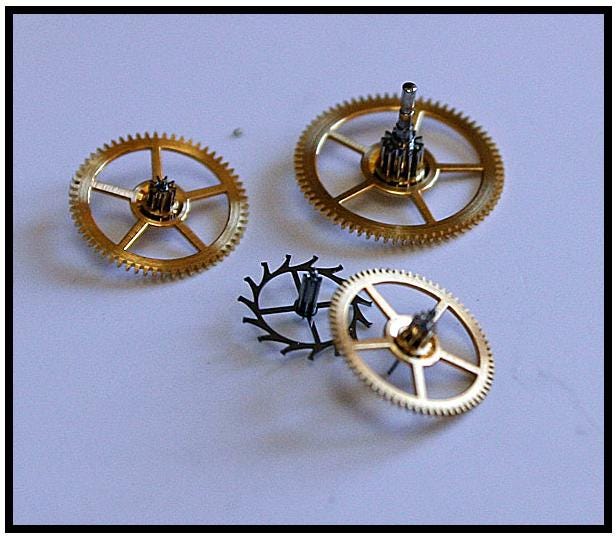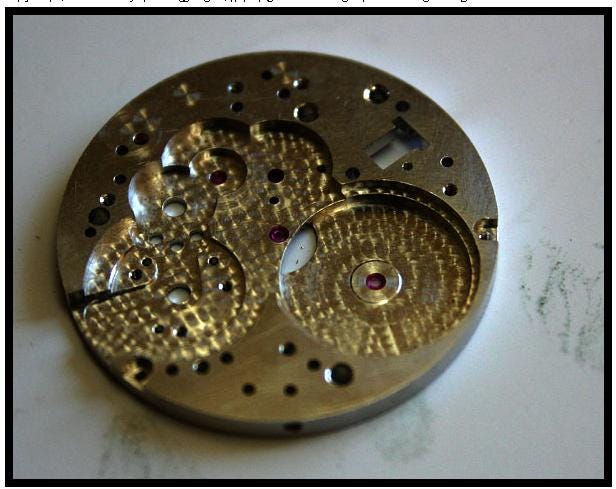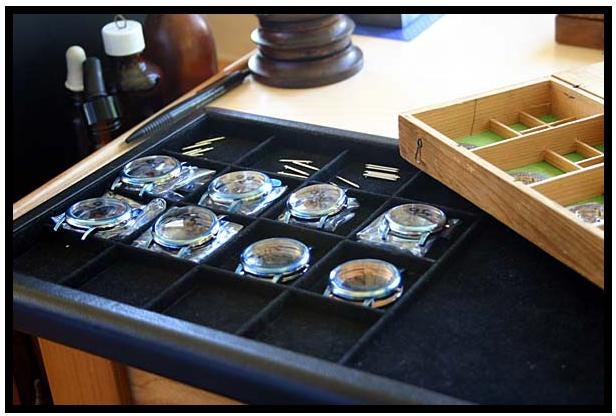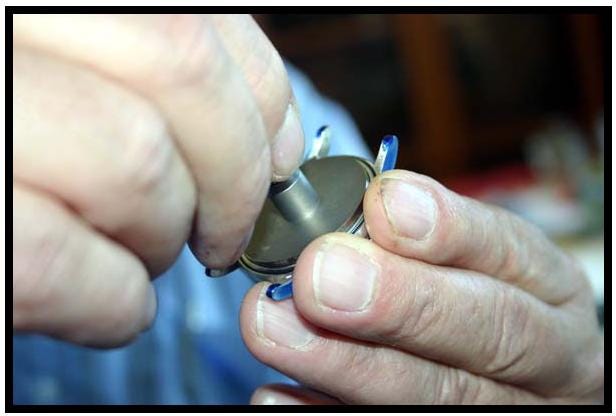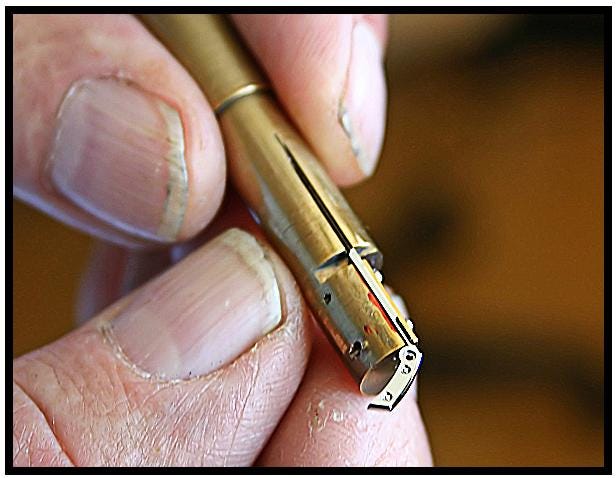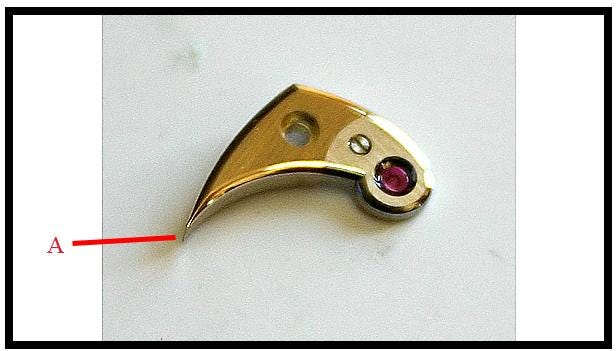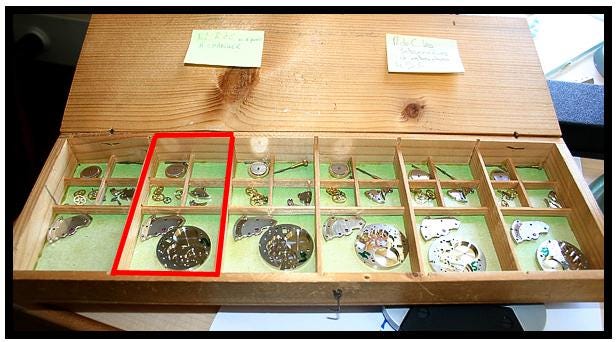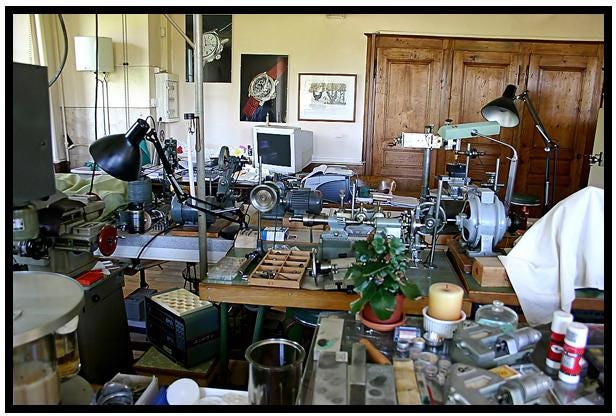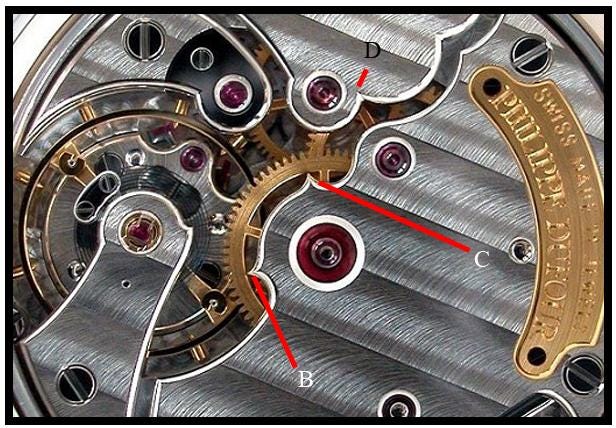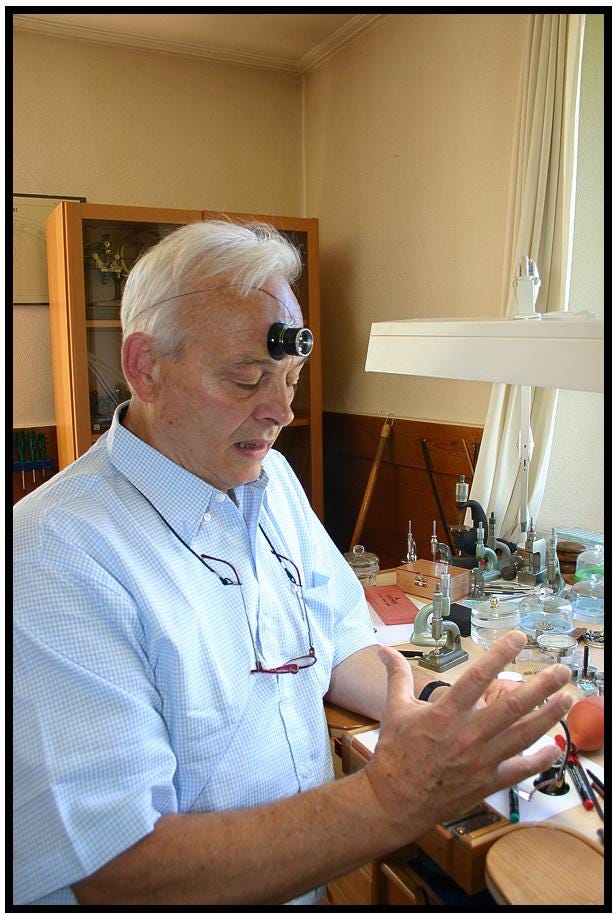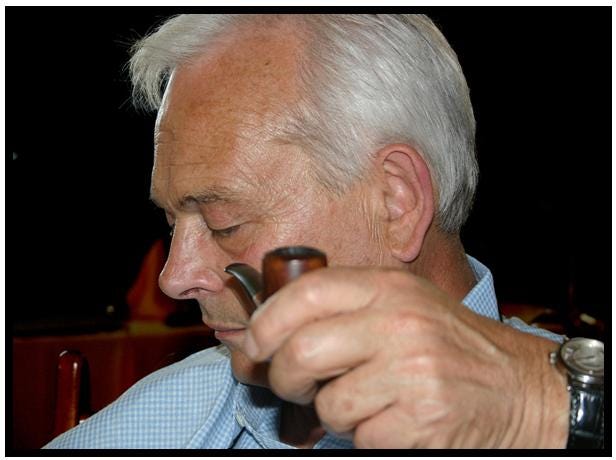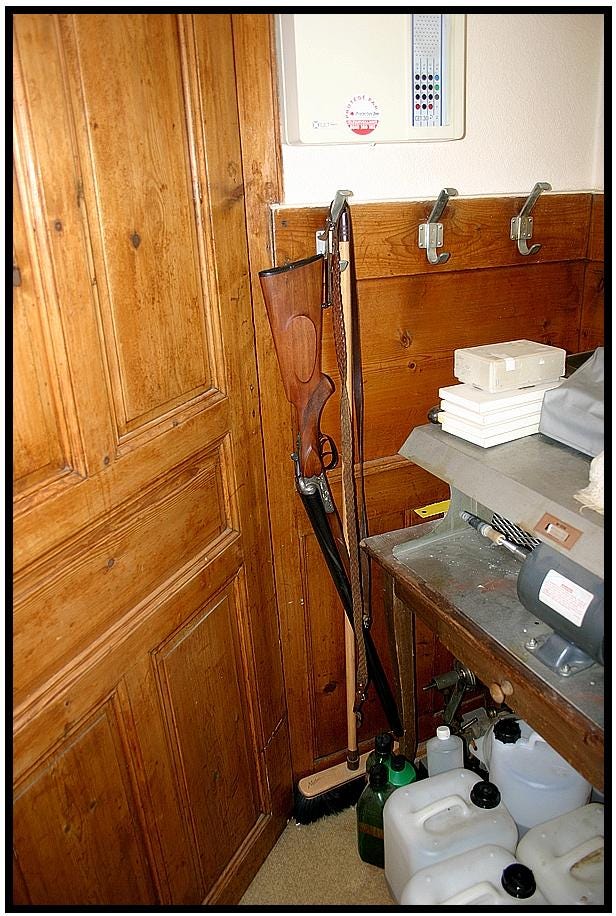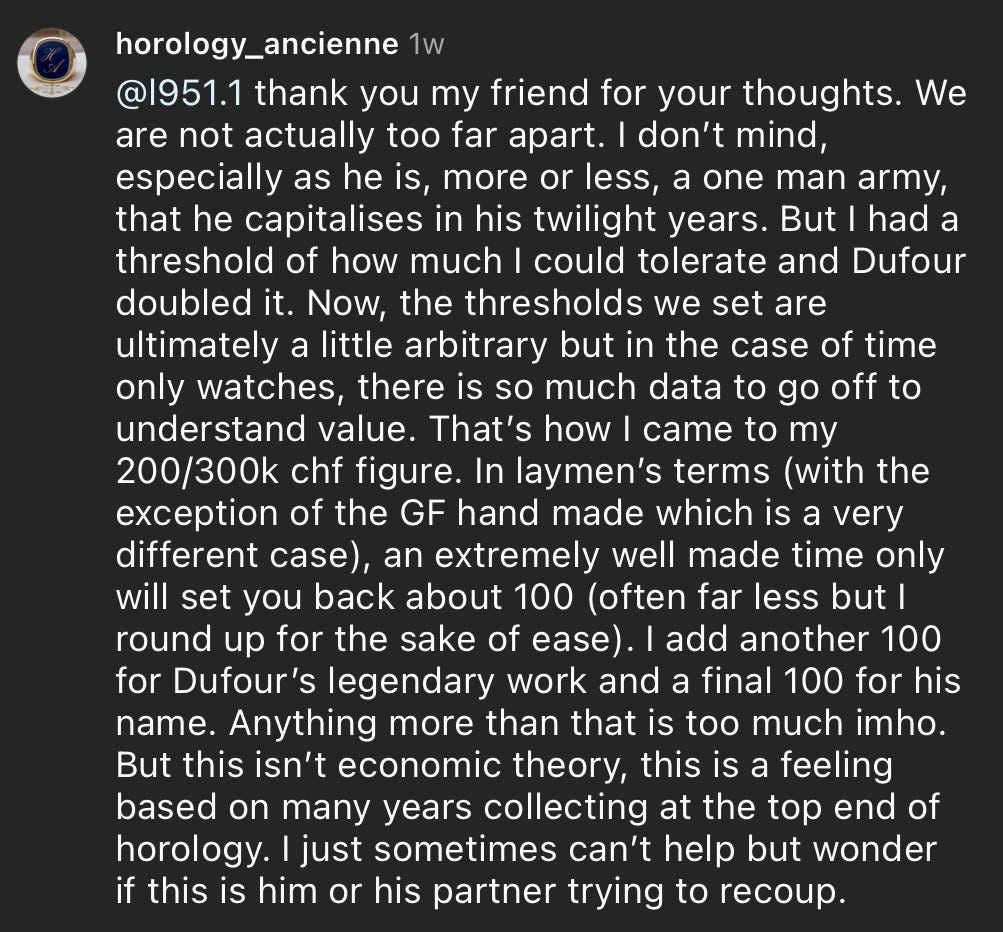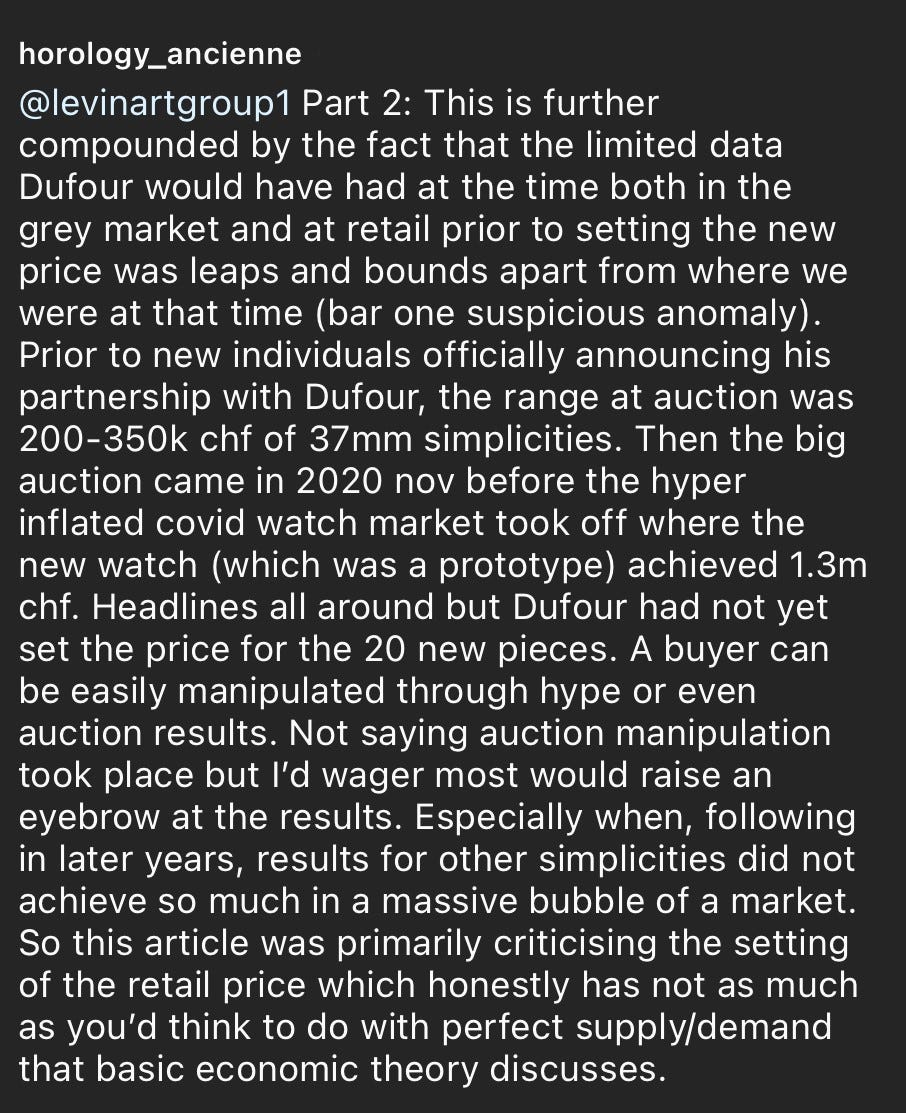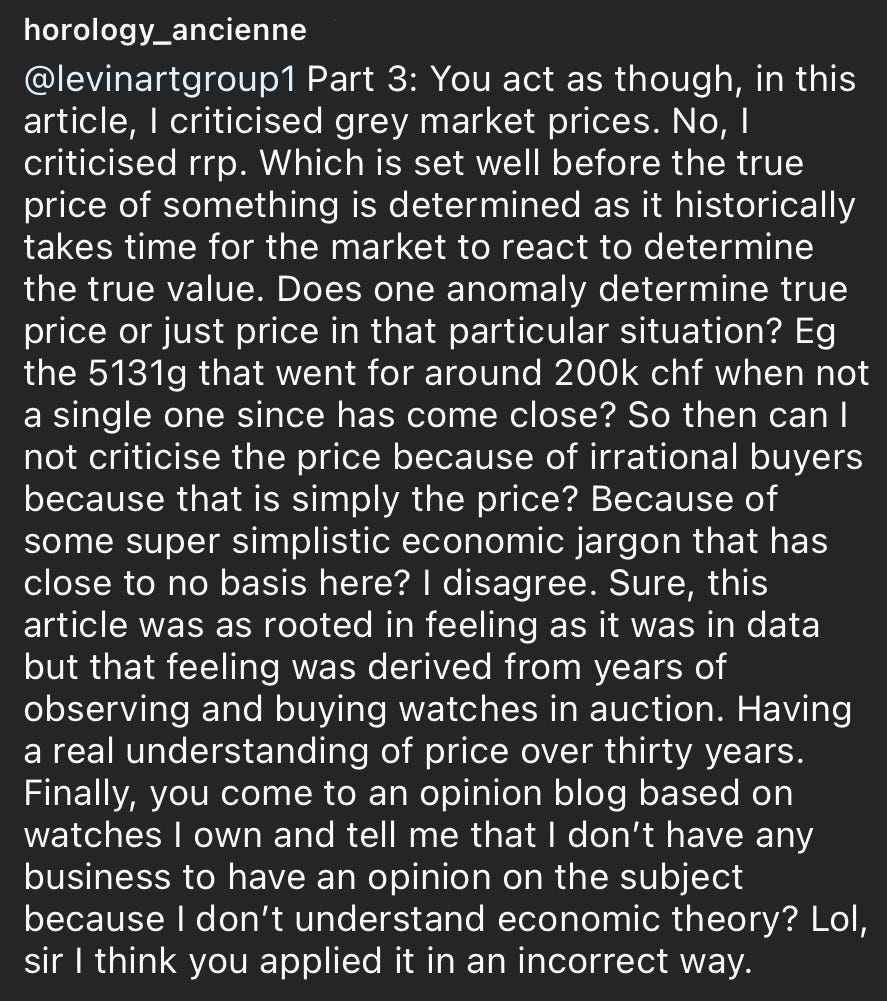Philippe Dufour Watch Sells for $1bn!
What is the true value of art? Are watches art? Is the value of watches which are compared to art, simply made up?
You probably knew before clicking through to read this post, that the headline is complete nonsense. How did you know that? Well, there is some sort of ‘reasonableness test’ which we apply to all things we see, hear and feel… and often, when something just doesn’t feel right, we do not need to do any fact-checking - our intuition tells us the correct answer in a split second.
That’s all well and good, but the problem with this approach, is that we can be fooled by our own intuition. I’m reminded of this old post which rings true as I think about this post, and my reason for writing it. Perhaps you have seen it before, but if not, here it is:
How fake news works
This video is epic because it highlights some textbook approaches to the creation of disinformation, and for us collectors, it provides a useful baseline for understanding how today’s online ecosystems have exponentially boosted the reach and effectiveness of such activities…
Before diving into those tactics, a bit of historical background from Thomas Rid’s Active Measures: The Secret History of Disinformation and Political Warfare1 might be helpful - Here’s a clipping from a CIA summary (not even kidding!) about the book, just to whet your appetite:
The levels of detail in Active Measures’s Cold War-era case histories reflect the thoroughness of Rid’s research. He combines declassified CIA records and documents released by Moscow (including official SVR histories), with material from East German and other former bloc countries’ archives—because of close cooperation of the bloc services, copies of documents still locked away in Moscow or destroyed by one eastern service often are available in another country’s archives—and interviews with retired East European intelligence officers.
As Rid explains - the United Nations started investigating the Soviet Union’s use of chemical weapons against Afghani muhajideen fighters in the early 1980s. The bulk of the U.N.’s evidence had been sourced and submitted by the United States (who were secretly funding the muhajideen and keen on stymying the Soviet Union); it was also being released to the public, damaging the USSR’s international standing. Operation Infektion was one of a series of active measures that the USSR undertook to deflect attention from itself by accusing the U.S. of creating biological weapons; Including a claim that the CIA was producing weaponised mosquitos at a malaria research lab in Pakistan!
One interesting point Rid observes is that for the USSR, exposure of these disinformation campaigns carried little risk — and could even further its objectives. He writes:
“Even if the Soviet claim that the CIA was developing chemical weapons in Lahore was revealed as fake, that revelation would make it easier for the U.S.S.R. to claim that the CIA’s reports of Soviet chemical weapons in Afghanistan were equally made up.”
The video illustrates the initial article from the Patriot went dormant for a few years before resurfacing again. Rid connects this to an accusation made by the U.S. in 1985 that the USSR was not in compliance with the 1972 Biological Weapons Convention. Basically, as with the weaponised mosquitos, the purpose of Operation Infektion was to discredit the United States and reverse the accusation.
In assessing Operation Infektion’s success, there are five key areas that facilitated the operation: 1) ease of entry (into the information ecosystem); 2) offering nuggets of truth; 3) a long game; 4) repetition; and 5) low levels of trust.
India was a hotspot for KGB active measures. As the KGB spies in the video point out, third world countries offered easier penetration of media outlets and greater plausible deniability for the true source of stories. Importantly, India — the world’s largest democracy — had a robust free press at the time (maybe not so much today!). Creating a new front like the Patriot (which Rid notes was funded by the KGB for the purpose of publishing KGB propaganda and disinformation) is easier in an open society with a commitment to free expression. As a bonus, India’s media ecosystem has many English language outlets, offering a convenient entry point for disinformation to get picked up by the west.
Weaponised mosquitos may seem a bit silly, but in the early 1980s, the idea that the CIA might be conducting experiments using biological agents wasn’t completely outrageous. During the 1975 Church Committee oversight hearings, then CIA director William E. Colby testified to Congress about various covert activities the CIA had undertaken over the previous decades which were outside the scope of its legislative charter — the so-called “family jewels.” These included coups, attempted assassinations, and of course… clandestine drug experiments on human subjects (including unwitting U.S. citizens)! Known as MK-Ultra, the CIA operation conducted studies on mind control, brainwashing, and psychological torture, often using psychotropic drugs like LSD and heroin.2
The U.S. also has an ugly history of human experimentation on Black Americans. Between 1932 and 1972, the U.S. Public Health Service conducted nonconsensual experiments on 600 Black men at the Tuskegee Institute, to study the effects of untreated syphillis.
So you see, the general notion of Operation Infektion was temporally and substantively close enough to real historical events to make it believable. In fact, Rid observes that the Patriot piece cleverly invoked the CIA’s past and…
“was a masterfully executed disinformation operation: comprising 20 percent forgery and 80 percent fact, truth, and lies woven together, it was an eloquent, well-researched piece that gently led the reader, through convincing detail, to his or her own conclusion.”
Operation Infektion taking root in the public imagination was helped immeasurably by the fact that it was repeated so many times in so many different places — two hundred times in 80 different countries! Research has shown that repetition makes information more credible: This is known as the illusory truth effect: Repetition is so powerful that individuals can perceive information to be true even when the source is not credible and even if they know from prior knowledge that the information is false. This will be a key point to bear in mind, with regards to the topic of this post i.e. the Dufour story.
In the case of Operation Infektion, as is the case with all watch-related infamy… repetition — particularly across many media outlets — will impact journalists’ perceptions. In the AIDS story, the fact that so many other publications had reported “the story,” for example, would have likely impacted the vetting process of the CBS Evening News to determine whether it was credible enough to include it in its programming. “Virality,” therefore, is a key ingredient in allowing disinformation to take root — and underscores why counter narratives are so important in the information space. In fact, that’s basically the point of this very post you’re reading.
The time elapsed between the AIDS story first hitting the Patriot to finally going mainstream on CBS was about five years. Sure, the AIDS story was one of several similar (failed) attempts. The KGB allowed the initial post to remain slightly dormant in the background until circumstances made it useful to resurrect again. The point being, it may never have become useful, but I do wonder how this applies to watch-related media as well. I will not elaborate for now, as you may choose to stop reading and label me a conspiracy theorist - I am not, but I think it doesn’t hurt anyone to think beyond the seemingly obvious motives.
So, what the actual f*ck does fake news have to do with Dufour? Well, let’s find out.
Why I decide to write this post
After the whole pricing debate about Dufour Simplicity Watches kicked off with Horology_Ancienne’s post on Instagram, I got several responses like “Dufour doesn’t make his own watches”, and “he does very little himself”, and “he only really did the movement decoration and nothing else”. Well, that’s an awful lot of negativity for someone who is, by most accounts, one of the most celebrated names in watchmaking alive today… isn’t it?
Now I am happy to admit, I don’t know any of this to be true or false. I don’t have any skin in the game, but I found myself having to form opinions with incomplete information. So in light of what I shared at the start about doing the work before forming opinions… here we are!
I decided to see what I could find. After a while, I landed on a useful blog entry by one Peter Chong, which I will share below - but this was at the very end of a rather arduous web ferreting session with mostly expired links on old forums and other similar dead ends.
The most overwhelming thing was the near unanimous conclusion that Dufour is “the master of our time”, “a watchmaker without equal”, “an absolute legend” and other similar praise which idolises the guy. Talk about confirmation bias!
If you feel like reading some of the material I found along the way, here are several links to warm you up:
Watchscapes: High Resolution Photography by Peter Chong: Dufour Duality (peter-chong.blogspot.com)
Brand History: Philippe Dufour – The Amateur horologist (wordpress.com)
Philippe Dufour’s journey to becoming a watchmaker – A COLLECTED MAN
How Philippe Dufour crafts the world’s finest watches – A COLLECTED MAN
From the Bench: Philippe Dufour | Read the interview in The Journal – A COLLECTED MAN
Philippe Dufour Interview: Why He Is Disappointed With Today's Watchmakers | aBlogtoWatch
Philippe Dufour | On Independence; Rolex & Lange; Watchmaking With Tim Mosso (Video, 25 mins)
Nicholas Hacko Watchmaker: Go and buy a Dufour! (nickhacko.blogspot.com)
BREAKING NEWS: Philippe Dufour watch sells within hours at world record $7.63 million (watchpro.com)
A Collected Man Is Selling a $1.3 Million Philippe Dufour Simplicity – Robb Report
This is by no means an exhaustive list (obviously!) - and since you have access to Google like everyone else, please feel free to add other useful links in the comments section.
The making of a simplicity
This entire section is a post created by Peter Chong in July 2005, and at the time, he was the owner of Simplicity Watch Number 7. My understanding is Peter still owns this watch.
So, to reiterate… this entire section is comprised of photographs and text by Peter Chong, unedited. I reached out to Peter and he was happy for me to include this here, so let’s proceed… Thanks again, Peter!
Much has been written about Philippe Dufour, his mastery of the craft of watchmaking, his insistence on perfection, his stubborn-ness to remain close to the art of his forebears, his open-ness to sharing with collectors and other watchmakers alike.
I have been close to the man for many years, since the mid-1990s, when he made his mark as the creator of the wristwatch Grande Sonnerie, and of the Duality. I visited him again at his booth in the AHCI stand in Basel 1998 when gingerly, he told me that he had created something different from his earlier creations. Something so simple, in watchmaking terms, he called it the Simplicity.
This marvel in watchmaking has been making storms amongst cognicienti around the world. The initial run of 100 pieces have been completely been taken up, and Philippe is now taking orders for the next 100, with deliveries extending to 2008.
The watch is available in either a rose gold, white gold or platinum case, and in two sizes - the traditional 34mm, and in 37mm. And in three dial options - silver or grey guilloche dial with applied dagger markers, dauphine hands, and in a printed white dial with roman numerals and blued steel Breguet hands.
This is quite simply, pun intended, the best finished watch in current production.
In this article, I explore with Philippe and showing pictures of the Dufour Simplicity - being constructed in his atelier, unplugged...before finishing.
The overcoil - How the coil is wound
The Breguet overcoil is bent to shape by hand. First, the flat coil as purchased from an old source is put on the scope and the magnified image thrown onto the screen where it is matched with a tracing of a theoretical overcoil is overlaid. The calculated curve is shown below.
The hairspring is from a new old stock. Picture below shows the size of the hairspring.
The hairspring is then bent to shape manually, using two pairs of tweezers, and coaxed, tweaked to follow the theoretical shape. This is a laborious process and needs the eye hand coordination that not many watchmakers today possess.
The wheel train
Each part is finished to the highest possible degree. The photograph below shows the linear drawing showing the engagement of the wheels, and the shape of the teeth. Philippe taught himself AutoCAD to be able to prepare drawings like these, which are required by the CNC operators to program their machines to cut the wheels. The wheels are then hand finished with hand chamfering.
Shown below is the movement plate, yet unfinished, just returned from the CNC machinist. The edges are sharp, and require some polishing before it is ready to receive the wheel train. Philippe uses the double assembly method, to ensure that he can make the adjustments to the wheel train by assembling it, and then taking it apart before applying the final finishing to the movement. This is to ensure that he can make adjustments and ensure the wheel train works properly, and also to make sure that when the adjustments are done, he does not mar the exquisite finish characteristic of the final product.
The wheels are then placed in their places with the pinions inserted into the jewels, and the wheel train is thus set, as shown below. The pinon teeth of second wheel, which turns at the rate of one revolution every hour, engages with the mainspring barrel.
Shown below, is the wheel train, showing the chamfered wheels from barrel to 5th wheel. Also shown is the black polished barrel. The wheel train below is at the stage of first assembly, before the final finishing of black polishing and Geneva stripes.
The wheels are finished by chamfering and polishing the teeth. Not many watches are thus finished. Shown below, counter clockwise from top right - the second wheel, the third wheel, the fifth wheel, and the fourth wheel.
The balance is then assembled, and the movement put into beat. The first rough adjustment is then made. When Philippe is sure the watch is ticking well, he disassembles the whole train. And begins the task of finishing the plate. Shown below is the plate with the perlage completed on the recessed areas. The faus cotes are then applied, and finally the anglage applied to the edges for the final finish.
The case
The case is made in accordance to Philippe's specifications. “Case makers are not precise people”, he says with a grin. Shown below is a tray of cases, finished by the casemaker, and waiting for the movements.
Philippe is obsessed to ensure that the movements fit the cases completely, without any movement rings, and he needs the movements to be precisely machined, so that its diameter is within 0.01mm of the internal diameter of the case. To ensure this, he first make these case holders shown below in sizes of 0.01mm increments. These blanks are used to measure the inside of the cases.
I know of no other watchmaker who does this, most would merely put in a longer securing screw, or a movement ring.
“I use these blanks to measure the internal dimensions of the case like so”, pips Philippe.
With this, he knows exactly how much to cut the movement blanks, so it fits snugly, without any movement blanks. Shown below are the movement blanks, after returning from the CNC machine, before any finishing.
Philippe examining the finish.
The click
Philippe's approach to the click follows the tradition set by Valee de Joux artisans from the turn of the century. Much thought has gone into the design of the click, which takes the form of a very beautifully machined piece, chamfered and polished to mirror finish.
Shown below is the click spring, held by a special tool used to keep it in place during the finishing. Note the glint of the anglage as it catches some light.
Cap jewel
As is traditional in the Valee, the jewel of the fifth wheel sits on a black polished steel cap, which is cut, polished, and set into the fifth wheel cock.
Note the sharp outward pointed edge of the cock, marked A. Sharp points, either outward pointing or inward, are very difficult to execute, and only possible by hand.
The assembly workflow
The workflow for finishing and assembly of the Simplicity is in accordance to the atelier style, meaning that one watchmaker is completely responsible for finishing and assembly, and adjustment necessary.
In the picture below, each compartment, an example shown in red outline, contains all the parts to make up a watch.
A view of the workshop is shown below...under the clutter, the genius works.
Philippe takes a break once in a while to enjoy his pipe...
The movement
The movement of the Simplicity. What can I say? This is definitely one of the best designed, well finished movements in existence.
The design of the bridges follow a complex shape, which demands a level of competency from the watchmaker that few today posses. The sensuous curves of the main bridge is accentuated by two sharp horns to allow for the protrusion of the jewel of the canon wheel. Seen below, marked B and C.
Marked D in the picture above, shows the well executed inward turning point. The inward point is particularly difficult to execute, and is seen here in perfection.
Many modern movements are cut on a CNC machine is finished by machine, and are not able to achieve the sharp points illustrated in the Simplicity above.
Note also the dicourveture of the jewel framed by points B and C. This chamfering of the bridge is also well polished, and shows smooth, clean edges to allow the jewel of the canon pinion to shine.
Photograph note: this photograph was shot with available light of the sun streaming in my window. See the brilliantly polished anglage of all the bridges and cocks catching the glint of the natural light. Lens used was a Sigma 28-70mm, mounted in reverse to allow for high magnification. Shot on Canon EOS 630, with Fujicolor ISO200 film, scanned by drum scanner. Image reduced by Photoshop CS. No sharpening or levels were used.
The portraits
In case you don't pay your bills, Philippe has this by his door, on the way out....
That concludes Peter’s post - which you can find here (Accessed July 2023).
Sfeir in the lair
How is it that most of the available resources online seem to paint the man as being an unrivalled genius, and yet the niche circle of watch collectors who congregate on Instagram seem to have other views? Is it a case of misinformation? As far as I know, these people have no skin in the game. The ones who do (owners, auctioneers, friends, etc) only say good things. Is it just envy, jealousy or schadenfreude? Perhaps it is a mix of several things, including biases, misinformation, and commercial strategy.
I have not found anyone who suggests that Dufour’s watches are not finished impeccably. Even the naysayers referenced above, were critical of the notion that he didn’t do the entire watch by himself, and it is therefore not ‘purely’ his own creation (Not saying this is a problem for me, just restating an argument made by some).
Of course, these watches were available for ~40k at some point - let’s say ~$40,000 USD in 2000, so that would be ~$70,000 in today’s money. Now, accounting for his increased fame and hype; and also adjusting for ‘portfolio’ pricing and the relative cost of other, more complicated watches such as Patek Minute Repeaters, this is where @Horology_Ancienne came up with his ‘acceptability’ figure of around 300k being an approximate ‘fair value’ for the watch today - as opposed to the 650k quoted retail price for the final series of 20 pieces.
Now, hold that thought for a second, and let’s explore developments between the retail price being below 50k, and the retail price leaping up to 650k.
In November 2020 (note this date when you see the chart below), along with his old friend (Dufour), Claude Sfeir announced that he was officially taking over the commercial activities, sales and distribution of Philippe Dufour’s production, as well as instigating the creation of 21 (new) Simplicity 20th Anniversary watches.
To quote Claude Sfeir from this Europa Star article:
“It has to be said that on 8 November, the first Simplicity 20th Anniversary was sold by Aurel Bacs for Phillips for the sum of CHF 1,361,000. Enough to arouse people’s interest. In the space of 48 hours, I received 10,000 requests. 4,700 emails a day. All kinds, from all over Asia and elsewhere. Lots of young people. Each one told their story, tried to convince me of the purity and profoundness of their intentions. There was all sorts, a thousand anecdotes. But in the end, there will be only one person per country. With Philippe, we attributed the first ten watches and for the remainder we’ll hold a lottery in the presence of a judicial officer. Philippe Dufour will keep N°21 for himself and his family. And we have other projects, a grand project, really high-flying, a ladies’ chiming watch combining watchmaking and jewellery. Between you and me, I have to confess I pushed him a bit...” (laughs).
That last bit in bold, is funny - but also poignant.
To quote the NYT:
“Philippe’s watches trade at top prices without him benefiting,” Mr. Sfeir said during a telephone interview from Beirut in late January. “He has not been getting the credit he deserves, so we decided to look ahead together not as business partners but as family.”

So this sets the scene to better understand the intent of Mr. Sfeir’s involvement. This is a savvy businessman who is among the most well-connected people in the watch industry… Not only as an expert collector, but also as a boutique owner, and a close friend of perhaps every person in major watch media. What do you think his goals might be? Sure, he wants to help a friend retire with abundant rewards for is life’s work - but also, we cannot ignore the obvious win-win that arises as a result; Dufour’s win, is Sfeir’s win. Is this a problem? Not at all. Just stating the obvious here.
Here’s another fun read from the FT entitled “Bezel friends forever: the duo behind the world’s most expensive jewellery watch” written by Nick Foulkes. (If the link doesn’t work, paste the title above into Google and it should come up - you should really pay for it, but I didn’t make the system; if you exploit it, that’s on you!)
To quote Faulkes’ article:
“Claude has beautiful ideas,” says Dufour. “And when he saw this project for the 20th anniversary of Simplicity, he said, ‘Why don’t we put the first watch into auction?’ It was a great idea.” Sfeir agrees emphatically. “The November auction was a lesson for all the watchmakers in the world,” he says, hinting that the sale is just a foretaste for what he and Dufour will unveil later this year.
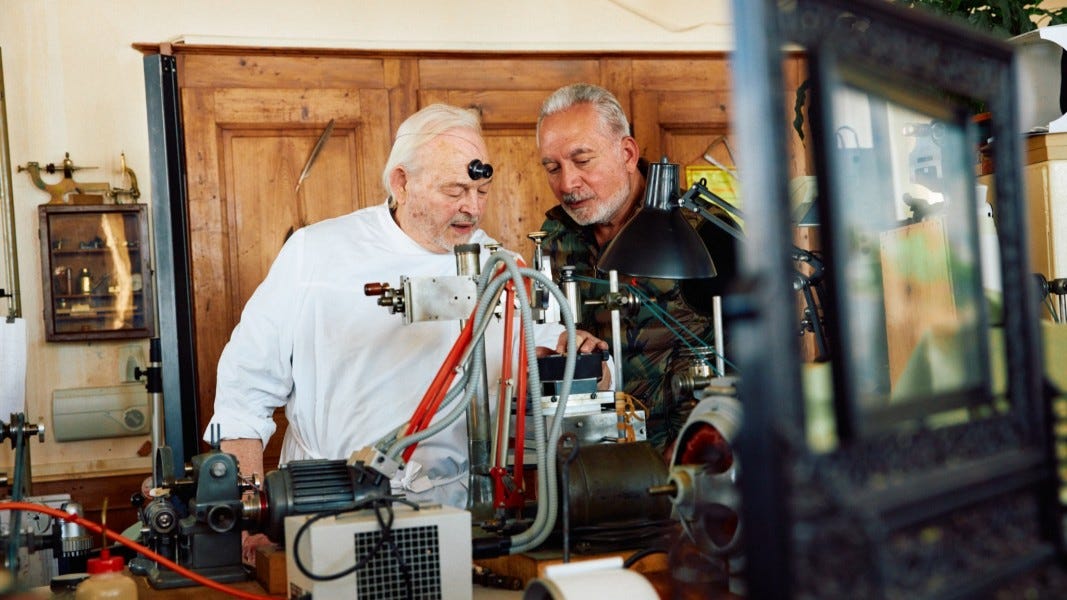
Now take a look at this chart:
Which result stands out? Indeed - the one which occurs in November 2020! The previous high was in October 2020… less than half the price! Remember, at this stage, the MSRP of the final Simplicity was not set, according to Hodinkee. Worth noting as well, the ‘COVID-fuelled craze’ in the watch market hadn’t really kicked in until 2021. So, is this really organic market demand?
Update/Edit March 2024: Following all this help from Sfeir, it seems Dufour and Sfeir no longer get along. This is supposedly due to the Dufour family being opportunistic, and ungrateful or blind to the magnitude of Mr. Sfeir’s help over the years. Despite having more juicy details to substantiate and warrant this update, I obviously can’t get into detail here, but at some point you may see the dramatic back story as a work of fiction with changed names.
The Stanford Prison Experiment
If you will allow me a brief digression, I have an interesting analogy to bring to the table. The Stanford Prison Experiment is a famous study conducted by psychology professor Philip Zimbardo, to explore the psychology of prison life.
You can read about it in more detail via the Wikipedia link above, or dive deeper into it via their interactive website with videos and images. I will gloss over the details and cover some of the key outcomes, and then get to my point too!
The study recruited people using a local newspaper ad, and student volunteers were randomly assigned to play the roles of prisoners or guards. These “prisoners” were arrested at home, without prior notice, by actual police officers, then handcuffed and brought to the prison in the university basement. They were then treated like prisoners (stripped, sprayed, clothed in uncomfortable prisoner-clothing, numbered) and locked up.
The “guards”, were given complete control over the prisoners, with only one rule: no physical violence/harm allowed.
This simulation was planned for two weeks, but unfolded at lightning speed. The guards embraced their roles with a fervent intensity; Implementing harsh rules, carrying out psychological torture, forcing the prisoners to engage in degrading activities, and even staging rowdy night-time raids. The subjects internalised their roles so deeply that the boundary between the experiment and their identities began to vanish. (Keep this in mind for Dufour owners and allies later on)
The prisoners, despite entering this study voluntarily, started to exhibit genuine signs of psychological trauma. They reacted to their conditions with passive acceptance, rebellion, or learned helplessness. (Keep this in mind for the watch collector community later on)
So, a mere 6 days after starting, Zimbardo terminated the prison experiment. What was supposed to be a simple study of prison behaviour, had turned into a horrible testament to how rapidly and deeply a group of normal individuals could be drawn into the roles they found themselves in - even when fully aware of the circumstances.
In Nazi Germany, soldiers were often given orders that dehumanised, brutalised and murdered millions of human beings yet, when confronted later, many claimed they were “simply following orders!” This defense that has since been labeled “superior orders” or the “Nuremberg defense”, which basically says people should not be considered guilty of committing actions that were ordered by a superior officer or official.
In The Stanford Prison Experiment, the guards were given a role along with ‘permission from an authority’, and these entirely normal individuals were able to inflict harm on others without personal remorse or responsibility. In other words, there was a particular environment where the abdication of personal responsibility became acceptable, and this led to deplorable outcomes.
The point here is human nature, under certain conditions, can be dangerous; people can distance themselves from their own actions to a worrying extent, and even adopt roles that allow them to behave in ways they would otherwise never condone.
The modern equivalent of the Stanford Prison Experiment
If you allow for some creative thinking - We become prison guards today, via the screens through which we interact with other people online. Digital personas provide us with anonymity and distance - as a result, people feel empowered, maybe even entitled, to behave in ways they would not dare to in a face-to-face interactions.
Just like the guards in the experiment, many people are often unaware of how deeply they are internalising certain roles, or how much they are altering behavior, attitudes, and even our self-perception.
To make things worse, the feedback mechanisms of praise, reposts, and followers have a powerful conditioning effect. They trigger a rush of dopamine - a neurotransmitter associated with reward and pleasure - each time we receive a positive response. This constant pursuit of validation and social reward can prompt us to amplify our behaviour, leading us further down the rabbit hole of extreme views, polarising discourse, and divisive behaviour.
The problem is… this experiment has no end! We do not have Professor Zimbardo to pull the plug after 6 days of hell. We have to step back and question the roles we’re assuming, the identities we’re forming, and the dynamics we’re participating in.
Every one of our interactions contributes to a narrative, endorses an identity, and reinforces a behaviour or belief. Are these narratives, identities, beliefs and behaviours reflective of our true selves and our core values, or are they distortions borne out of an unconscious need for digital validation, acceptance or even ulterior motives?
Concluding remarks
Perhaps it is now clear why I started this post with a discussion about fake news - you will notice how I also included an entire list of links too. I challenge you to conduct your own deep dive, and see how difficult it is to easily access information about Dufour, and get a better insight into the watches - both the older ones, and the newer ones which have not all been delivered yet. The ability to make statements about the man, unchallenged, is why the question of value is so challenging.
This narrative being so broadly accepted speaks to a situation which is easily manipulated.3
Following the Instagram post last week, there were varying opinions on who makes the Simplicity watches today, whether or not Daniela Dufour would be making them instead of her father (which is what I assume people pay for!) - and of course, whether the newer watches had been finished to the same standard as the older ones (such as Peter’s shown above). Many interested parties weighed in, and of course, they are all entering the conversation as “guards” as described in the prison experiment. They do not care about fact-checking, or about burden of proof - they have ‘earned the right’ to have a ‘valid opinion’ on the basis that they are experienced collectors, and many of them own these watches - this means they are ‘more right’ than others who have not seen the watch.4
Perhaps; Although I would simply see their perspective as one of many valid perspectives. Just like you can see a watch right now and decide it is rubbish… you’re entitled to that opinion. In a larger sample of educated watch collectors, there is often a consensus (such as Dufour being a legend) and all I was getting at this whole time, is this: Despite Dufour being a legend, everyone will still have varying opinions on how much his legendary status is worth when translated into real world money. As you can see from Peter’s post above, Dufour used to do a fair bit of work himself. What he does today, and how much is outsourced to his daughter or others, is anyone’s guess. For this reason, I will say that old watches most definitely ought to be worth more money.
For the purposes of this post, I would break it down into price, and value. The price of an object in an open market is driven by supply and demand (perceived, or actual, is a different conundrum). The value of an object will have varying meaning depending on who you ask. If you take an inexpensive watch which belonged to a deceased family member, it can have immeasurable value to the owner, despite having a low price.
This notion of value is what Horology_Ancienne is talking about in his comment above. To him, and to many others who agreed with his sentiment in the post - the market at large can ‘ collectively agree’ the value of “a time-only masterpiece by a bona fide legend” being possibly up to 300k - or at least, that’s what HA said, and everyone (myself included) tended to agree broadly based on his rationale. If you have time, read this long post on the subject.
Beyond that, any addition to the retail price is supposedly not justified - when comparing with other relevant and equally rare, special, or complicated pieces on the market. Of course, if you were Jeff Bezos, and somehow became a serious watch collector… then bought into the stories above about Dufour being the best of our time… this 650k watch would seem like a total bargain even at a million bucks or two; And you would be fairly confident that you’ve got yourself the crème de la crème, right? That’s the sort of thing which Dufour is hoping for, of course. He isn’t concerned with selling to watch collectors and offering value. That’s his right, as is your right to say “no thanks”.
Is it greedy? Well, given we’re talking about retail not market price - probably yes. Is it bad? Aside from auction results which appear to be manipulated (but unproven), probably not. When you have willing buyers at a certain price, whether the price was set through trickery in auctions or not - I suppose you can’t hate the player… just hate the game.
Here’s a quote I recall quite often (and it is often misattributed, as this fellow explains):
We Don’t See Things As They Are, We See Them As We Are
-Anonymous
What is the most succinct summary of my thoughts? Dufour is a skilled watchmaker, who is celebrated, and many people have a vested interest in overpromoting him - even without accurate data - because there is only upside for doing so. The concept of value is unique to each person, and should be decoupled from price discussions. The rules of the game may not be in our favour, most often due to the absence of infinite money… but as always, we remain free to stop playing the game.
I will conclude with a final anecdote:
At a party for New Jersey Senator Bill Bradley in 1987, Tennessee Senator Albert Gore included a fanciful tale about the former basketball star in a speech he gave in his honour. Soon after Bradley entered the Senate, said Gore, he was invited to make a speech at a banquet and sat proudly at the head table waiting for his turn to speak.
When the waiter came over at one point and put a pat of butter on his plate, Bradley stopped him. “Excuse me,” he said, “can I have two pats of butter?”
“Sorry,” said the waiter, “one pat per person.”
“I don’t think you know who I am,” said Bradley. “I’m BILL BRADLEY, the Rhodes Scholar, professional basketball player, world champion, United States Senator.”
“Well, maybe you don’t know who I am,” retorted the waiter.
“Well, as a matter of fact, I don’t,” admitted Bradley. “Who are you?”
“I’m the guy,” said the waiter, “who’s in charge of the butter!”5
In this case, watchmakers are “in charge of the butter” - all we need to do is figure out whether we can see through all the fog in the room and tolerate the rules, or whether we should see ourselves out; Because, the truth is, every single experience and worldview is unique, and we all see the world as we are.
The end! Glad you made it… what did you think?
Active Measures: The Secret History of Disinformation and Political Warfare. By: Thomas Rid. Published 2020.
Check out this documentary for more information if you’re interested: The Man Nobody Knew: In Search of My Father by CIA Spymaster William Colby
Side note on manipulation: Roger Smith has been piggy backing on this idea of taking advantage while the popular opinion is hot, and he has even less cause to be considered an all time great like Dufour, as far as I am concerned. His boss George was an all time great… but that doesn’t automatically mean he is great too. I have been told by several people (some who are waiting, others who have cancelled their order) how Roger asks for down payments, years before delivery, and then increases the prices as he goes along… PRE-delivery… i.e. after having agreed a price at the point of deposit being paid. Sure, he can do what he likes - but my 2 points on Smith: 1) his watches are not actually ‘worth’ that kind of money, so watch out for manipulation, or join in the fun now before they escalate 2) that sort of behaviour is arrogant, and I hope it stops - he seems like a nice bloke, but his hubris might be getting in the way now. That said… Value is in the eye of the beholder, right? If enough people like Todd Levin and Silas Walton at A Collected Man decide to continuously promote Roger as being the equivalent of George Daniels, then in about 20 years his work will be ‘obviously’ worth obscene amounts of money because, well, “20 years of evidence proves it, right”?! What a joke.
I heard a story about Daniela not even passing the watchmaker’s exam, and being ushered through the process because of her father’s influence. Other reports suggest she can’t even assemble a watch herself. I have no idea whether this is true, but I mention this only to reiterate how deep you have to dive, to protect your investment in with this ‘brand’ - if this is true, can you just imagine the extent to which they would go to hide this? The belief in “her ability” being comparable with her father’s, is itself worth millions now!
Source: Boller, Paul F. “The Reagan Years 1981-89.” Presidential Anecdotes. New York: Oxford UP, 1981. 276. Print.



